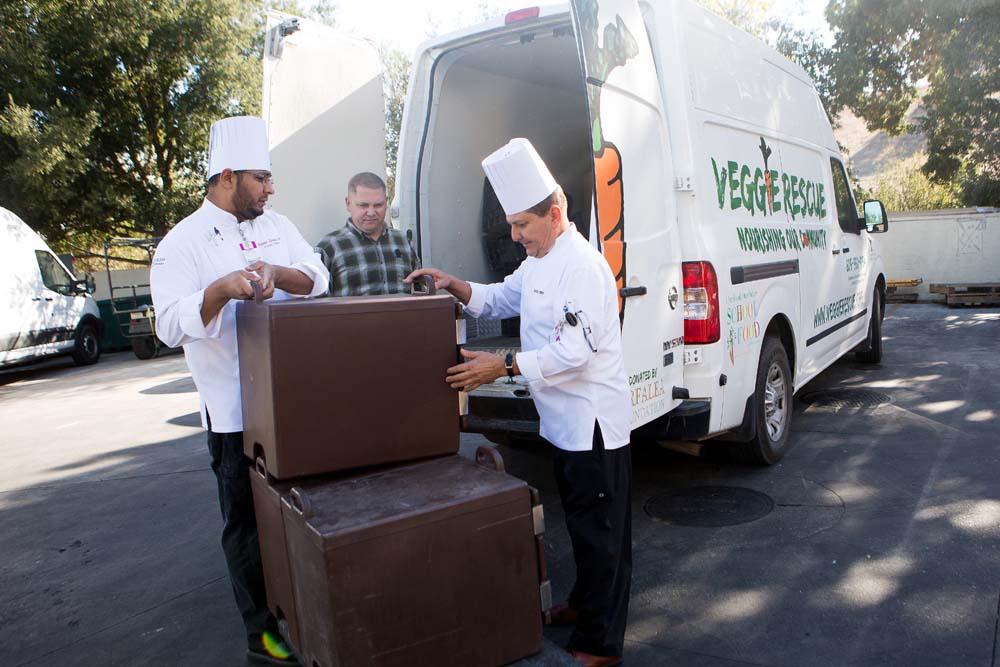By Laurie Jervis
Contributing Writer
As national and global agencies spotlight food waste, a Santa Barbara County nonprofit organization has been working behind the scenes since November to move leftover food from buffet lines to hungry senior citizens.
Santa Ynez Valley Fruit & Vegetable Rescue, more commonly known as Veggie Rescue, is based in the Santa Ynez Valley but works throughout the county to glean excess produce from commercial farms, orchards and backyard gardens for delivery to needy families and schoolchildren.
Since its launch nearly eight years ago, Veggie Rescue has delivered slightly less than 1 million pounds of food, according to executive director Amy Derryberry. In 2016, she told Noozhawk that her organization’s goal is simple: “We want to feed fresh, local food to our community.”
Derryberry outlined the process by which Veggie Rescue came to team up more recently with the Santa Ynez Band of Chumash Indians to collect unconsumed food — both warm and cold — from the casino’s buffet lines three times each week for delivery to the Buellton Senior Center.
In November, Veggie Rescue launched a pilot program for a prepared food recovery effort, she said.
“This program was supported by the Community Environmental Council and had guidance from the county Public Health Department and financial backing from the Santa Barbara Foundation’s LEAF Landscapes, Ecosystems, Agriculture and Food Systems) grant program,” she said.
The concept was formed during a meeting organized by the Santa Barbara Foundation and the CEC, which helped the agencies involved understand both food insecurity and food waste within Santa Barbara County, Derryberry said.
The participants came away from the meeting with a big goal: Identify a donor facility and pair it with Veggie Rescue’s ability to transport food to a network of recipient organizations, such as senior centers.
“With our years of experience delivering produce in our refrigerated van, this seemed like a natural expansion of our program — redirecting food that would have been sent to the landfill, and instead feeding it to fellow community members struggling with food insecurity,” Derryberry said.
When the Chumash were contacted, the tribe quickly agreed to the plan as part of its efforts to eliminate waste by 2019, she said.
“The tribe’s partnership with Veggie Rescue is an example of the creative ideas our Chumash Casino Resort’s Facilities Department has implemented to help reach our goal of becoming a zero-waste facility by 2019,” said Kenneth Kahn, tribal chairman.
“We’re proud of this partnership, because Veggie Rescue prevents quality food from being wasted and makes deliveries to those in need. It’s reassuring to know that the extra food we’ve prepared is nourishing members of the local community.”
When Derryberry reached out to Pam Gnekow of the Buellton Senior Center about utilizing the rescued food for meal programs, she got an enthusiastic response.
“There are so many seniors in need of good food in our community, and we are thrilled to be the recipients of this terrific food, which allows us to expand our capacity to feed seniors,” Gnekow said.
An additional benefit of the Chumash-to-Buellton Senior Center plan was the short distance between donation and delivery, Derryberry said.
Once the plan was in place funding was necessary, and it came in the form of the Santa Barbara Foundation’s LEAF initiative and its Santa Barbara Food Systems Grant program, she said.
The county’s Department of Public Health trained the Veggie Rescue staff on how to keep the transported food at the correct temperature and log the pickup and delivery temperatures, Derryberry said. The casino’s kitchen has a commercial rapid cooling system used to cool and then store the leftovers for Veggie Rescue, which retrieves the pans every other weekday, she noted.
When the Santa Barbara County Grocery Rescue Program debuted Nov. 6, the Veggie Rescue team arrived at the casino and was escorted to the kitchen adjacent to the buffet area. Twenty-seven aluminum trays were pulled from the refrigerator, temperature checked and then loaded into insulated containers for transport to Buellton.
The first trays weighed in at 67 pounds and included chicken, fish, pasta, mashed potatoes and an assortment of vegetables, Derryberry said.
Since the program’s debut, the Buellton Senior Center has received deliveries three times each week, with each week’s total averaging 220 pounds.
The senior center has incorporated the deliveries into its on-site hot meals, as well as the Meals on Wheels meals the staff produces five days each week, Gnekow said.
“Our meals are more diverse with the addition of the prepared food,” she said.
Derryberry noted that expansion plans for the food rescue program include the city of Santa Barbara and, eventually, the entire county.
“It’s great to be able to redirect the food” to those in need, she said.
Go to www.veggierescue.org for more information.
Laurie Jervis tweets at @lauriejervis and can be emailed at winecountrywriter@gmail.com.






